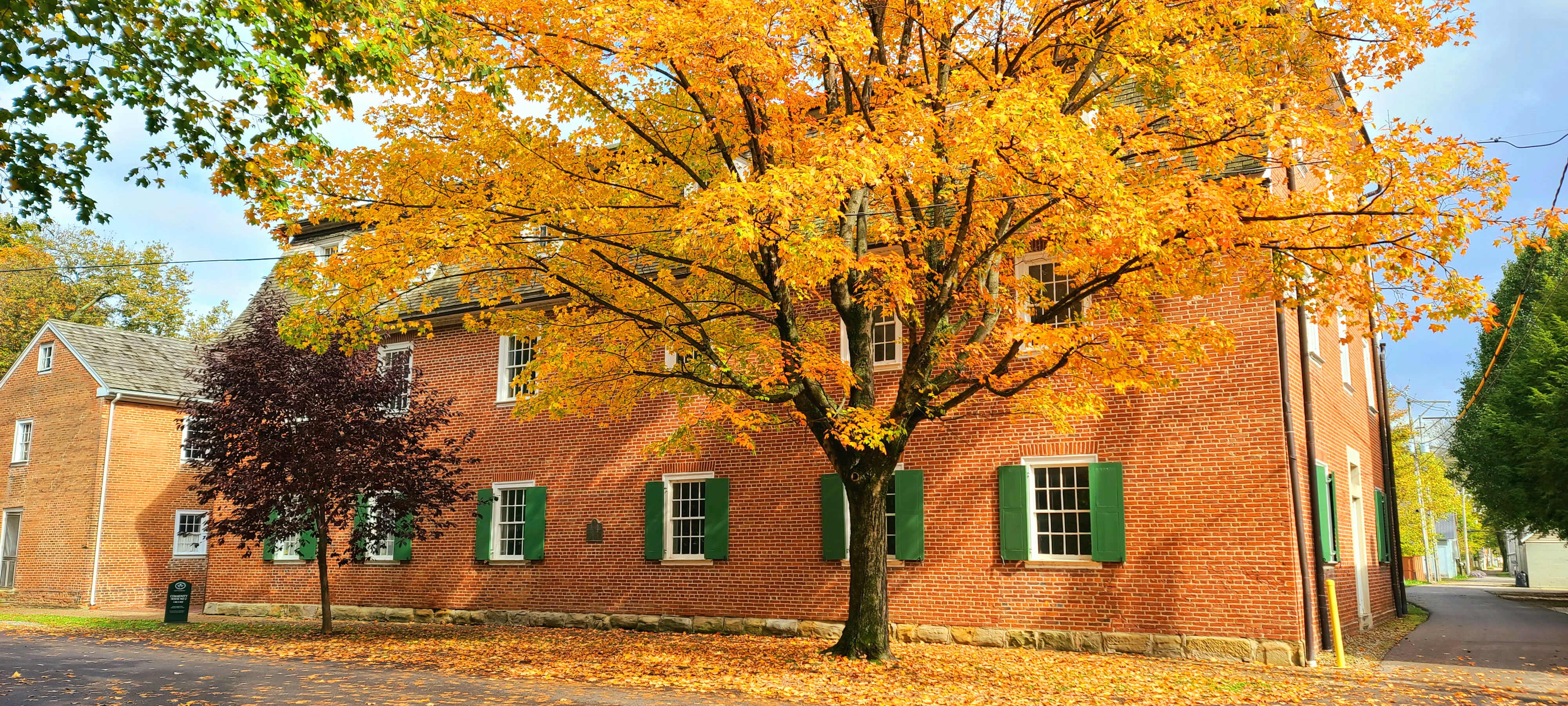FEBRUARY 2023
Jess McPherson, New Harmony State Historic Site Coordinator
This winter, the Harmonist Labyrinth has been shining bright at night to guide visitors through its hedges. For decades now, people have walked around the path of this replica Harmonist labyrinth to achieve a thoughtful, ponderous state leading to clarity and discovery. The journey often symbolizes finding the solution to a problem and achieving understanding. Others view the labyrinth as a metaphor for a spiritual journey, with the entrance representing birth and the center symbolizing God, knowing or enlightenment. Getting to the center requires a long, arduous journey of growth. And now, for the first time ever, visitors can take this journey after the sun has gone down. This is all thanks to some beautiful string lights which now envelope the hedges. All of this was thanks to some amazing volunteers headed by Mary Beth Guard of Caper’s Emporium.
Not only does the labyrinth represent growth and journeys, but it now also represents the tight-knit community that is New Harmony. To see everyone come together not only to acquire the solar-powered lights, but to also install them all and then use drones to take some photographs (provided by Ted's Drone Service) was inspiring. I am already aware of the joy and love that lives in New Harmony, but it is especially beautiful to see that joy and love embodied in a physical form. It is definitely a must-see for tourists coming through the area.
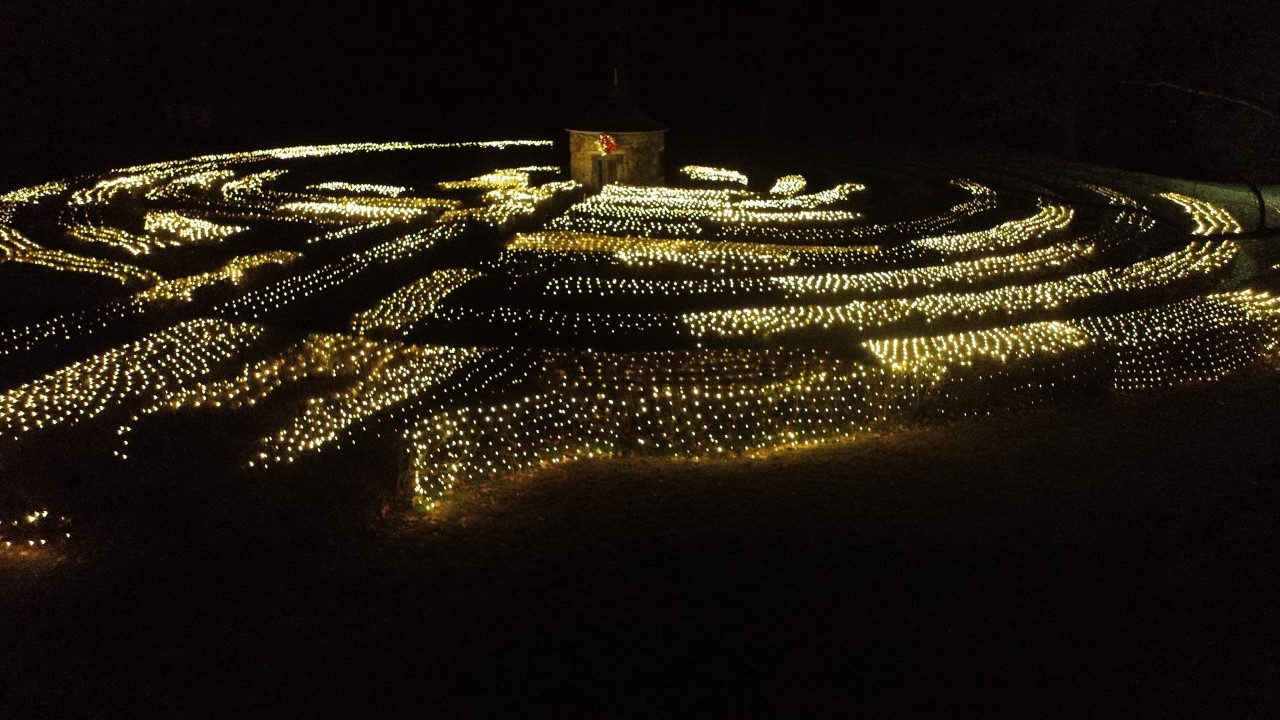
Jess McPherson, New Harmony State Historic Site Coordinator
Every year, New Harmony turns into a Hallmark movie during the first weekend of December. The town held its famous annual festival, Christmas in New Harmony, December 2-4 and it was a blast. This was my second time working and attending the weekend festivities and if you haven’t made it out to see it for yourself, you really should next year. This was also the second year the Indiana State Museum opened the doors of Community House No. 2 for artisan vendors. 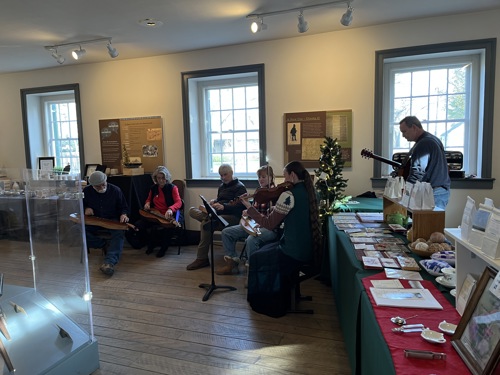 We also provided space for the Children’s Center for Dance Education to host their performance of “The Nutcracker.” In addition to these events, New Harmony also offers a tree lighting ceremony, a pub crawl, horse-drawn carriage rides, a gnome scavenger hunt and many more fun activities for visitors and families to enjoy. The town is filled with music, laughter and the enchanting smell of fresh kettle corn and hot chocolate. I wasn’t exaggerating when I said the town turns into a Hallmark movie. It really does feel like you’re escaping from a bustling, over-worked life into the quiet magic of a small-town Christmas. It was especially my pleasure to decorate and assist in the Community House artisan sales this year. Not only were the artisans all lovely to speak with, but they also brought such a variety of handmade crafts. Vendors brought everything from homemade tea to 3D-printed Christmas ornaments, each item made from a labor of love. As always, I am already excited for next year’s Christmas in New Harmony. If you’re interested in making your way to town for the next first weekend of December, I suggest looking into booking a stay now. The town fills up quickly with visitors coming to enjoy the weekend!
We also provided space for the Children’s Center for Dance Education to host their performance of “The Nutcracker.” In addition to these events, New Harmony also offers a tree lighting ceremony, a pub crawl, horse-drawn carriage rides, a gnome scavenger hunt and many more fun activities for visitors and families to enjoy. The town is filled with music, laughter and the enchanting smell of fresh kettle corn and hot chocolate. I wasn’t exaggerating when I said the town turns into a Hallmark movie. It really does feel like you’re escaping from a bustling, over-worked life into the quiet magic of a small-town Christmas. It was especially my pleasure to decorate and assist in the Community House artisan sales this year. Not only were the artisans all lovely to speak with, but they also brought such a variety of handmade crafts. Vendors brought everything from homemade tea to 3D-printed Christmas ornaments, each item made from a labor of love. As always, I am already excited for next year’s Christmas in New Harmony. If you’re interested in making your way to town for the next first weekend of December, I suggest looking into booking a stay now. The town fills up quickly with visitors coming to enjoy the weekend!
Jess McPherson, New Harmony State Historic Site Coordinator
This year, it was my pleasure to prep and plan a spooky program for the New Harmony State Historic Site to host in October. I decided I wanted to try to put on a murder mystery party. To make this event special, I chose to write the mystery myself. This was an ambitious experiment on my part, but I am happy to say that we sold out our tickets and had an amazing time!
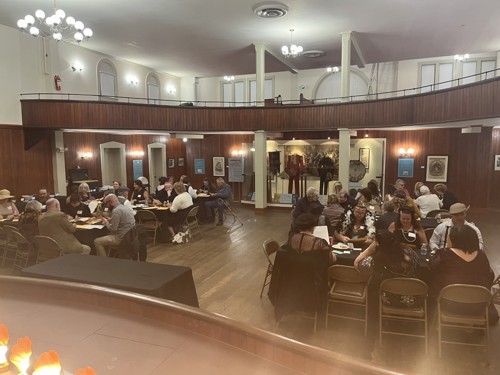
For those who could not make it this year, here is a summary of the plot:
Everyone has just arrived at Thrall’s Opera House expecting to watch the famous Silver Troupe perform a play. However, the star of the show—Miss Maxine Silver—is found dead in her dressing room just before the performance was set to begin. Based on the apparent injuries Miss Silver has sustained, it is clear that she was murdered. Throughout the night, the audience was tasked with interviewing each other to find clues and motives as the authorities updated them on their developments. Through this process, it is revealed who killed her and why.
For months, Maxine Silver was preparing for her and her fiancé, Mr. Benjamin Baker, to leave New Harmony for New York City. She kept this a secret except from a few select people but had been planning on telling more at her father’s afterparty. She knew most people in town did not approve her relationship with Mr. Baker. While this was going on, her father, Mr. Carl Silver, was getting himself into deeper and deeper debt with a group known as the Westside Gang. Mr. Silver had been purchasing alcohol on credit from the bootlegging gang to supply his extravagant parties, and he was starting to feel their noose tighten. On top of this, Mr. Silver had also been seeing his business decline in popularity which was leading to poorer and poorer sales over the past few months.
Roughly 45 minutes before the show, Maxine approached her father privately and ask him to join her in her dressing room. She told him of her plan to leave the next day for New York city, taking her fiancé and her talent with her. Carl Silver was immediately thrown into a blind rage. He saw her plans to move as a slight against himself, their family, and his business. Maxine was his brightest and most popular star. For her to leave now would crash his already crumbling business. In his blind rage he grabbed the closest weapon he could see, the sheers Maxine had taken from Mrs. Goodwin, and stabbed his daughter in the back of her neck, dealing a deadly blow. Mr. Silver immediately fled the premises to return to his home near by and clean himself up. After doing so, he rushed back to Thrall’s Opera House before the performance was set to begin in hopes of providing himself with a false alibi.
As I mentioned before, everyone had so much fun mingling at the party, playing a character, and getting dressed up in their best 1920’s inspired costumes. With such success of the event, we will be sure to hold another one next year. Be sure to check out the New Harmony State Historic Site around October if you want to join in on the fun
Jess McPherson, New Harmony State Historic Site Coordinator
One of my many duties as site coordinator for the Indiana State Historic in New Harmony includes planning and executing exhibits. The state museum is currently hosting an exhibit on the Golden Troup’s famous Silver Band at Thrall’s Opera House. However, exhibits are usually only on display for a couple of years, and this one’s expiration is coming up. Therefore, I am currently working on planning the next exhibit, and I believe this one will be about the youngest of the Golden Troupe family; Frances “Fanny” Llewellyn Golden.
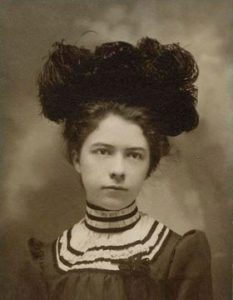 Born in 1877 in New Harmony, Frances Golden was practically born to be a star. Her parents were the famed Martin and Bella Golden, the faces of the Golden Troupe. A thespian family accompanied by the Silver Band and Orchestra, they traveled and performed across the American Midwest, Southwest, and South from 1875 to 1891. Fanny often joined in on performances and would play children’s roles in their plays. After their matriarch, Bella, fell into poor health and retired from performing, the group disbanded as a formal thespian troupe. Little Fanny would grow up and continue to pursue her passion of performing and later founded the Evansville Civic Theatre. But the one piece of her life I would like to focus on is her part in World War I.
Born in 1877 in New Harmony, Frances Golden was practically born to be a star. Her parents were the famed Martin and Bella Golden, the faces of the Golden Troupe. A thespian family accompanied by the Silver Band and Orchestra, they traveled and performed across the American Midwest, Southwest, and South from 1875 to 1891. Fanny often joined in on performances and would play children’s roles in their plays. After their matriarch, Bella, fell into poor health and retired from performing, the group disbanded as a formal thespian troupe. Little Fanny would grow up and continue to pursue her passion of performing and later founded the Evansville Civic Theatre. But the one piece of her life I would like to focus on is her part in World War I.
After studying Opera and Dramatic Arts in New York City, Frances joined a vaudeville circuit of traveling performers. This didn’t last too long, however, as America joined the Great War. Frances joined the YMCA’s “America’s Over There Theatre League,” an organization committed to entertaining U.S. troops in France at so-called “liberty theatres.” My favorite artifact I’ve come across, while researching Miss Frances Golden, comes from this era. It is a letter typed on the USS Black Hawk dated December 26, 1918 that reads:
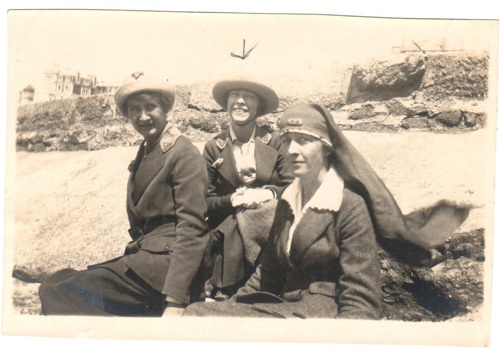
Smiles (Parody)
I have met some girls from Glasgow.
I have met some girls from Perth.
I have met some girls from dear old Paris
And thought them the finest on earth.
I met some pretty girls from England
And always let them have their say.
But the girls that filled my heart with sunshine
Were the girls from the U.S.A.
The above was written in honor of the Misses Bonnie M. Murray, Hinda Hand, and Frances Golden, American Y.M.C.A. entertainers, in whose company we spent a most enjoyable evening, December 26th 1918.
W.E. Wigmore
C.D. Northrop
It warmed my heart so much to think of Fanny and those two other women make their way over to war-torn Europe, met sailors who had suffered through the most intense and devastating experience of their entire lives, and spent a Christmas evening warmed by each other’s company. In the aftermath of such destruction and horror, imagine getting to spend an evening with three talented young women really made those young men feel like their hearts were filled with sunshine.
Frances Golden led such a colorful life full of passion and dedication, and a letter like this highlights her story so well. I am excited to continue to learn more about her through my upcoming research. Keep your eyes open for a new Golden Family exhibit coming to Thrall’s Opera House next year!
Jess McPherson, New Harmony State Historic Site Coordinator
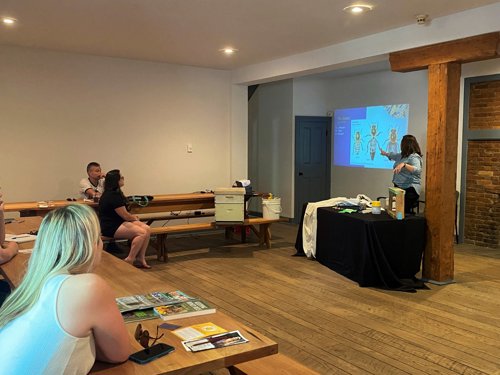
On June 4, the Indiana State Museum hosted a beekeeping class in Community House No. 2 titled “Beekeeping 101.” This was the first program I oversaw from start to finish as the New Harmony Site Coordinator. It was definitely a learning experience, but I am very happy with how the class turned out. It was taught by fourth-generation beekeeper, Kelsey Gerhardt, who is from Evansville and has a strong working relationship with the State Museum. We had seven people attend the class in total and each participant was given informational handouts and a sample of Kelsey’s home-grown honey. Along with her honey sticks, Kelsey brought along an “observation hive” (a single frame of a hive with glass on both sides) so we could observe the honeybees in their home. She also had a variety of models and tools for reference as she taught the class.
The class was incredibly informative and useful for our patrons looking to start their own hives. I’m happy to have the experience of coordinating the program under my belt for our next class, “Weaving Through Time.” This class will not only teach participants about Harmonist culture and industry, as well as make their own weaving project to take home with them! This class will be taught by a New Harmony local, Peggy Taylor, who is an expert historical weaver. Spots are still available so register soon!
Jess McPherson, New Harmony State Historic Site Coordinator
The Indiana State Museum and Historic Sites is once again utilizing the space in Thrall’s Opera House to display a new exhibit on New Harmony’s Golden family. “The Golden Troupe Superb Silver Band and Orchestra” gives visitors an insight into the band that supported one of the most popular theatrical companies of the late 1800s.
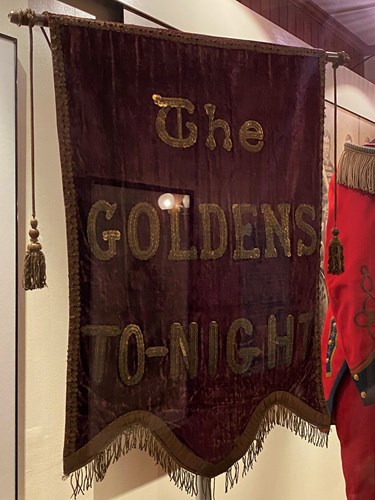
The mid-19th century saw the rise of touring theatrical companies across America. The Golden Family, the Silver Band and roughly 20 supporting actors visited communities across the South, Midwest and West. The Golden Troupe’s advance man would arrive early, place notices in local newspapers and paper the town with posters. The real excitement would begin when the Superb Silver Band paraded through the streets, advertising the upcoming performances. These parades were so important to a traveling troupe’s success that some contracts fined actors for not participating. Although it complements the Goldens’ name, “silver band” is a generic term for a brass band using silver-plated instruments. The plays they put on, usually a mixture of comedy and drama, were described by patrons as “lively and fascinating” and the wardrobe and scenery as “elaborate and elegant.” We are fortunate that much of the Golden Troupe’s theatrical material has survived—more than 650 objects, including costumes, wigs, shoes, hats, musical instruments, documents, manuscripts and photographs are part of the Indiana State Museum and Historic Sites’ collection. The objects on view here are from that collection.
I am delighted to have played even a small part in constructing our newest exhibit. Getting up close and personal with the uniforms and instruments I have been viewing through historic photographs was such a treat. I am excited for the people of New Harmony to get the same experience while visiting the exhibit.
Jess McPherson, New Harmony State Historic Site Coordinator
As a new manager of the Indiana State Museum’s historic sites in New Harmony, it has been my duty for the last four months to inventory, photograph and catalogue the thousands of artifacts the state museum stores in Community House No. 2. As a history buff, it’s been like a treasure hunt every day I come into work. Some treasures are less exciting, like the dozens of pewter plates or the hundreds of printing press stamps the museum owns. But other treasures, like the original silhouette portraits of the major figures of the Owenite period or the beautiful gowns of socialites’ past, have been a joy to handle and study. For this month’s newsletter, I thought I’d give a brief rundown of some of my favorite pieces in our collection!
First, we have this Harmonists era blue silk scarf with white and red floral detailing. The Harmonists famously raised their own silkworms and produced their own silk materials, and this artifact is an amazing representation of all their hard work. Even today, nearly 200 years later, the silk shines brightly in the light and the colors are as vibrant as ever. Truly a beautiful piece of history!
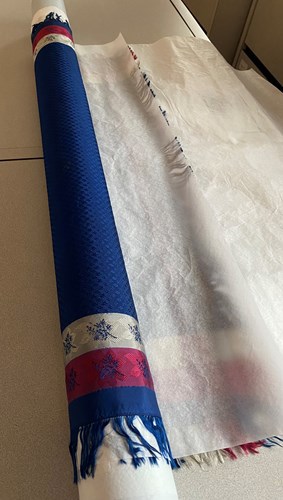 Next, we have an intricate German-style cuckoo clock from the 1880s. This piece was owned by the Mary Emily Fauntleroy and the Indiana Federation of Women’s Clubs before it was donated to the Indiana State Museum. The clock proudly displays an image of the 10 commandments at the point of its roof, showing how dedicated its owners would have been to their religion and moral beliefs. Its intricately carved details are what really make this piece stand out for me.
Next, we have an intricate German-style cuckoo clock from the 1880s. This piece was owned by the Mary Emily Fauntleroy and the Indiana Federation of Women’s Clubs before it was donated to the Indiana State Museum. The clock proudly displays an image of the 10 commandments at the point of its roof, showing how dedicated its owners would have been to their religion and moral beliefs. Its intricately carved details are what really make this piece stand out for me.
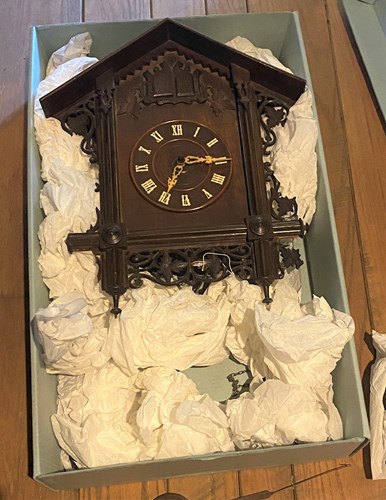
Finally, we have a hand hook rug woven in 1924. The design is of our very own Fauntleroy Home and shows off a vibrant and blooming garden out front by the walkway. I am unsure, however, who or what “Alexandria” might refer to. Perhaps it is the artist themselves? Either way, this rug represents a complete labor of love to me. You can tell whoever designed it did so with the intent to capture the natural beauty of New Harmony and the people who built it.
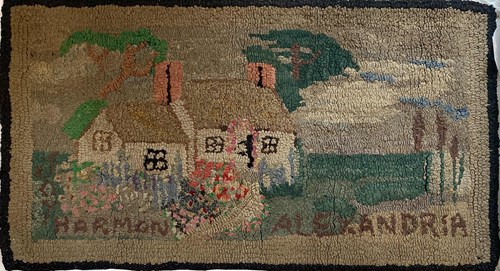
Every artifact in my care is special to me in one way or another. These three are just examples of the fascinating pieces I get to analyze here in the Community House. Every item stored here is literally a product of its time, and I believe the culture, morals and beliefs of those who created them are still harbored within them. It’s been an important job to make sure they are cared properly and will be in their best condition for future historians to write about in their newsletters. Thanks for reading this one!
Jess McPherson, New Harmony State Historic Site Coordinator
To the citizens of New Harmony; hello! My name is Jess McPherson, and I have recently joined the State Museum as the site coordinator for the New Harmony State Historic Site. I am a few weeks into the job, and I couldn’t be happier. It has been lovely to get to meet everyone who has stopped in so far. New Harmony is truly a welcoming and gracious home.
A bit more about me; I was born and raised a Hoosier by a family who has always encouraged a love and reverence of history. I graduated from Indiana University (IU) Bloomington in 2020, where I earned BAs in both History and Latin (salve socii fanatici historiae). I previously worked with the Monroe County History Center, the IU Archives and as a research assistant for the IU department of Anthropology. I have also worked in the community organizing various volunteer opportunities and political campaigns. Hence, why I am so excited to be able to facilitate programs and events as well as preserve the sites that make New Harmony historic!
Feel free to come knock on my door at Community House #2 to say hello. I’d love to hear any stories you may have about the place, what food I should be eating at the local diners or just to chat about the Harmonists! I am always here for a good history-centric conversation.
Mike Linderman, Southwest Regional Director for ISMHS
This summer is bringing some change to Community House 2. For the first time in over 20 years, all rooms on the second floor, that are not designated for artifact storage, will be open to the public. Finishing touches are happening now on the last room on that floor. In addition to reopening those spaces, we have installed Wi-Fi in the building. This addition will make the spaces more functional for those who may want to rent the space or for programming offerings in the future.
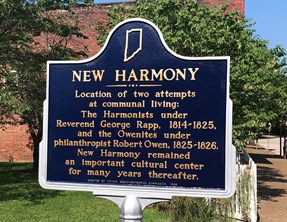
You may also notice that the Indiana Historical Bureau marker that has been in Redbud Park since the 1960’s has returned to its post after being refurbished. The marker looks as good as the day it was installed in 1966 for the sesquicentennial of Indiana.
As always, feel free to reach out to me if you have any questions about the Indiana State Museum and Historic Sites properties in New Harmony.
Mike Linderman, Southwest Regional Director for ISMHS
In 1937, The Daughters of the Minerva Society installed a large plaque on the side of “The Old Fauntleroy Home,” commemorating those individuals who had lived and worked in the house over the years. This plaque remained on the side of the house until restoration of the home began in 2012-2013 in preparation for the bicentennial of New Harmony. At that point it was removed and placed in storage in the adjacent barn. After being kept in the barn for nine years, our staff removed it and began to refurbish the plaque for future display inside the house. That work is now finished, and the plaque will return to public view for the reopening of the site this spring. In addition to this large plaque, this year our staff will begin working on the Indiana Historical Bureau plaque located in Red Bud Park to give it a fresh look.
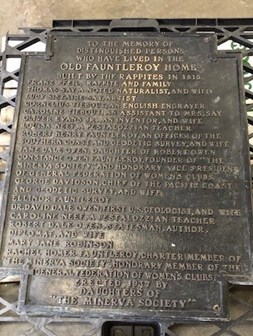
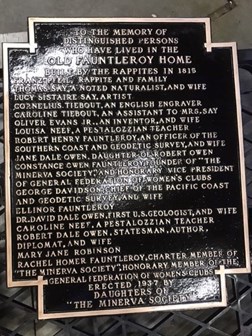
Mike Linderman, Southwest Regional Director for ISMHS
Our recent organizing efforts in the storage barn located beside The Fauntleroy Home resulted in the discovery of some very dated architectural elements! Our research shows that these pieces came from Community House #3–the building that stood where Red Bud Park is today.
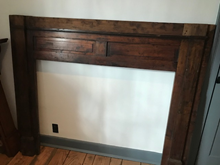
For most of its life, Community House #3 was known as “The Tavern” and had a hotel in it. It began to fall into serious disrepair by the late 1940s and was finally razed in 1960. We are fortunate that some conscientious people saved these architectural elements before they were lost forever.
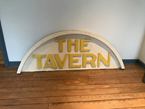
Our goal is to incorporate all of them into an upcoming exhibit at the Thrall’s Opera House scheduled for some time in the new year. This will be the first time any of these items have been seen by the public. Also included will be some of the gas station items we found in the attic of Thrall’s. Stay tuned for future updates!
Mike Linderman, Southwest Regional Director for ISMHS
Every so often the Harmonist Labyrinth in New Harmony needs some pruning to keep it healthy, and the labyrinth will be getting some much-needed trimming work done in December.
Over the years, the hedge has grown taller and wider than ever intended, and we will be performing a major pruning this winter to get the hedges that make up the labyrinth back to where they need to be. During the first half of December, work crews will begin trimming the feature to widen the pathways and shorten the height to its original configuration.
The labyrinth will look stark for the winter, but the hedges will rebound in the spring. Our goal will be to maintain the hedges at the pruned shape and size moving forward. If you have any questions about the labyrinth pruning, please contact Mike Linderman, Southwestern Regional Director for the Indiana State Museum and Historic Sites, by email at mlinderman@indianamuseum.org.
Mike Linderman, Southwest Regional Director for ISMHS
In 2011, the Indiana State Museum and Historic Sites began a major renovation of Community House 2, with a total repainting using historically documented colors. New exhibits were installed on the first floor that detailed the history of the building, and the print shop was reinstalled in its original location on the third floor. At that time, Harmonists’ bedrooms on the second floor were also closed with the intent of reopening them once renovations were complete. The building reopened to the public in September 2012, but the bedroom spaces had not been painted and remained closed.
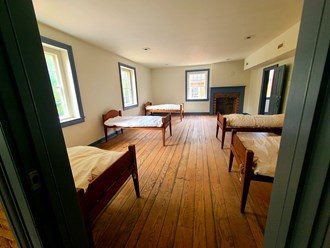
I am pleased to announce that we have reopened one of the previously closed bedroom spaces and have plans to open two more spaces very soon. The rooms are painted and are now ready for visitors for the first time in nine years! The reproduction Harmonist beds will be on display, and guides can show visitors what life was like living in the dormitory. In the past, visitors looked into the rooms over gates. Now, visitors can tour the actual space up close.
Mike Linderman, Southwest Regional Director for ISMHS
Often, we stumble over history right in front of us without realizing it. Case in point, the attic of Thrall’s Opera House. During a recent routine security inspection, a pile of old material in the corner that looked like it came from a gas station was pointed out to me. Many of you know that from 1913 until the restoration of the building in the mid-1960s, the building served as an automobile service station, complete with gas pumps along the street side of the structure. Automobiles were driven through the front entrance and pulled right into the main part of the building for repair work.
Upon closer examination, many of the items in the pile were definitely from the service station-several old Gates Manufacturing hose and belt wall racks, eight large parts storage drawers/bins stained with oil, pieces of a roll top desk and an interesting wooden conveyor belt. We decided to bring these items down into the light again for the first time probably since 1966, to photograph and document them as part of the history of this amazing building. The future use of these items is uncertain, but they may go into a temporary display in the building to highlight this lesser known period of the structure.
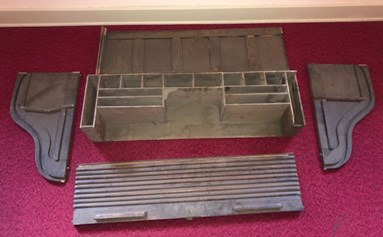
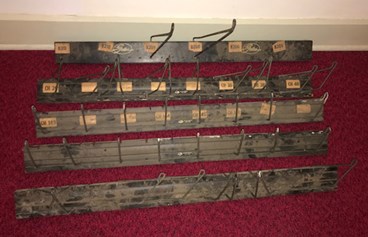
Mike Linderman, Southwest Regional Director for ISMHS
For those who don’t know me, my name is Mike Linderman and I am the Southwest Regional Director for the Indiana State Museum and Historic Sites. I oversee operations at three of our 11 state historic sites, Angel Mounds, Vincennes and New Harmony while working from my office located at Angel Mounds in Evansville. Some of my duties in New Harmony have expanded with the March departure of former Site Manager Meagan Patterson. Among those new duties is more hands on management of the site, which I am enjoying greatly. It’s been many years since I have had brick and mortar structures to care for – a big difference from 1,000 year-old Native American mounds.
Our goal moving forward is to hire a Site Programmer to make frequent use of our properties within the Historic New Harmony program. For instance, we are currently looking at new ways to use Thrall’s Opera House. We want to make it more of an active part of the community with more programming in that great space. As you can imagine, much of our planning is on-hold until we can reopen our facilities to the general public again.
If anyone would like to contact me about our properties, please do not hesitate to contact me via email at mlinderman@indianamuseum.org.
